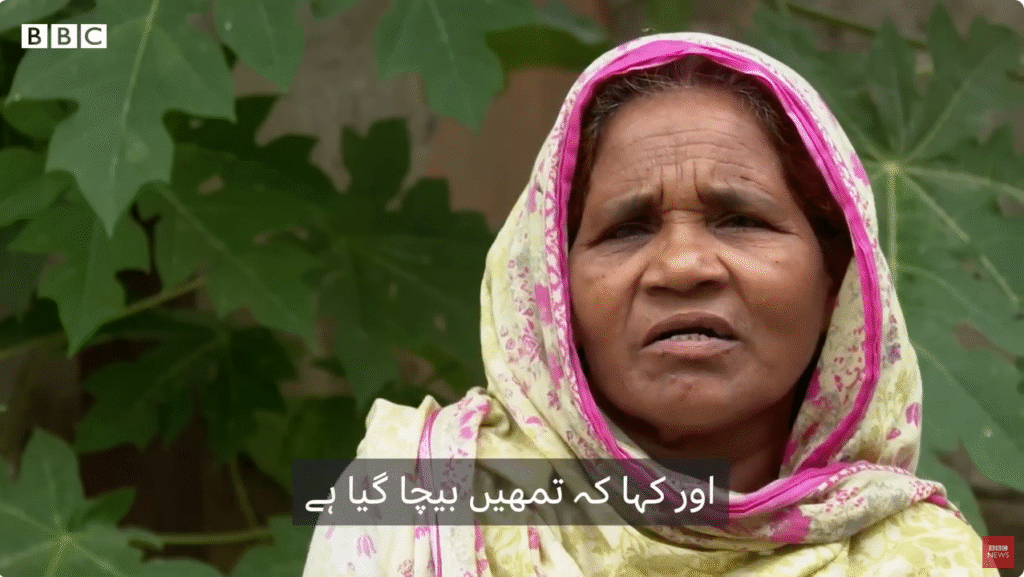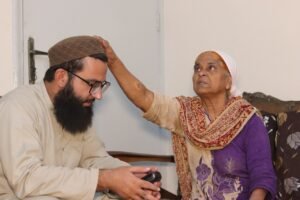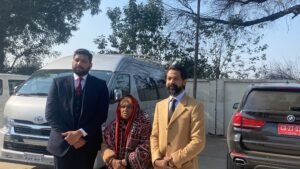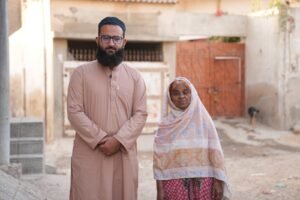Her name is Zahida.
I’ve known Zahida since my early childhood, growing up in the neighborhood of Manghopir, Karachi. She worked in various homes around the area, including ours. We used to call her “Nani” – grandmother – as a term of affection.
I vividly remember the day my mother quietly shared something with me that shook me to my core. She said, “Zahida was abducted from Bangladesh and sold here.” I was just a child then, but those words planted a lifelong sense of sorrow and disbelief in my heart. How could someone be kidnapped and sold like that?
Years went by. I grew up, finished school, and eventually got access to a mobile phone. The era of social media had begun, and like many others, I joined Facebook. I spent countless hours online, scrolling and sharing.
One day, my mother, frustrated at seeing me glued to my phone, scolded me. “Instead of wasting time uploading pictures, why don’t you bring Zahida home, write down everything she remembers, and post it on Facebook? Maybe her family will see it. We live in the age of technology.”
The idea hit me hard. The story that had haunted my heart since childhood now had a chance to find closure. I immediately asked my sister to bring Zahida over.
Zahida came. I sat with her and gently asked her about everything she remembered. I wrote it all down carefully.
On October 31, 2018, I made a Facebook post searching for her family. Here’s the original link:

A Reunion After 35 Years
Breakthrough
The post went viral. Thousands shared it. It eventually reached a young man in Bangladesh named Manzoor Ahmed, a religious scholar and university student. He was deeply moved and decided to help.
Manzoor traveled to the address Zahida had remembered from her childhood. But more than three decades had passed. The neighborhood had changed. A new generation now lived there. Everyone told him they had no knowledge of any girl being abducted from the area.
Disheartened, Manzoor began to head back home. On the way, he met an elderly man and shared Zahida’s story. The old man thought for a moment and then said, “Yes, about 35 years ago, a young girl did go missing from a nearby neighborhood. Let’s go there.”
They went together. When they shared Zahida’s name and details, the family there suddenly recognized everything. The names matched. Zahida’s mother was still alive. When she heard the news, it was as if life returned to her frail, bedridden body. She was nearly 90, but the moment she knew her daughter was alive—her strength returned.
We arranged a video call between Zahida and her mother. After 35 years, mother and daughter saw each other again. Tears flowed. Words failed.
Then came the next mission: bringing Zahida back to her homeland. It took two years of paperwork, but finally, we received her visa from the Bangladeshi High Commission. Friends helped us raise money for her ticket.
Zahida flew from Karachi to Dhaka. At the airport, Manzoor Ahmed received her and took her to his sister’s house. The next day, they began the journey to Zahida’s village. After 24 hours of travel, they finally arrived.
The reunion between Zahida and her mother was deeply emotional. The videos of that moment spread across the globe. They hugged, sobbed, and held each other tightly. There wasn’t a dry eye watching.
Zahida was only 18 or 19 years old when she was abducted. At that time, she was married and a mother of two. One of her children had been with her when she was taken; the other, an infant, was left behind in Bangladesh. When she finally reunited with her family, that very son—now a grown man with a family of his own—met her again for the first time.
This powerful story captured media attention, not only in Bangladesh but also internationally. BBC Urdu covered it in a feature, which you can watch here:
🎥 BBC Urdu Video
Since Zahida’s story went public, dozens of women who were victims of similar trafficking or abduction have reached out to us. As of 2025, we have helped reunite nearly 250 people with their families after decades of separation.
Zahida’s story is a painful reminder of the human cost of trafficking—but it is also a story of hope, resilience, and the power of human connection in the age of technology.






